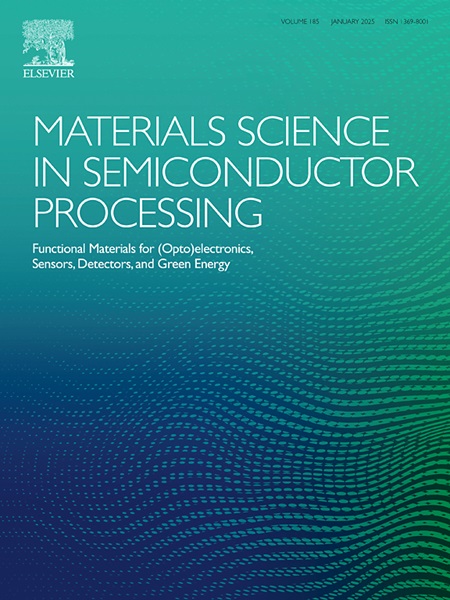正反体异质结有机太阳能电池中空穴传输层的作用:光强相关的电容电压分析
IF 4.6
3区 工程技术
Q2 ENGINEERING, ELECTRICAL & ELECTRONIC
引用次数: 0
摘要
在有机太阳能电池(OSC)中,空穴传输层(HTL)对提高功率转换效率(PCE)至关重要。因此,确定潜在的机制是至关重要的。在本文中,我们报告了一项研究,研究了两种HTL (PEDOT:PSS和MoO3)对正常(ITO/PEDOT:PSS/P3HT:PCBM/Al)和反向(ITO/ZnO/P3HT:PCBM/MoO3/Ag)配置下P3HT:PC61BM(有源层)基体异质结(BHJ)电特性的影响。电流密度-电压(J-V)和照明强度相关的电容-电压(C-V)测量已经执行并比较了使用和不使用HTL (PEDOT:PSS在正常和MoO3在倒置)器件。结果表明,含HTL器件的提取的光伏参数(短路电流密度(Jsc)、开路电压(Voc)和填充因子(FF))在正常和反向OSC下都优于不含HTL器件,这是由于无HTL器件中不利的载流子积累和带弯曲。这种在有源层/阳极界面上的电荷积累会产生光电压,作为PCE的损耗因子,并在不同照明强度(0/暗、50和100 mWcm−2)下测量的C-V特性中进行了研究。提取内置电压(Vbi)、有效内置电压(Vbi, eff)、累积载流子浓度和表面光电压(Vspv = Vbi, eff - Vbi)等参数作为光照强度的函数。我们的研究结果表明,在传统和反向OSCs结构中,具有低Jsc、Voc和FF值的无html器件产生更高的SPV。这里使用的SPV计算方法已被证明在为OSC设备架构推荐合适的html时至关重要。本文章由计算机程序翻译,如有差异,请以英文原文为准。
Role of hole transport layers in normal and inverted bulk heterojunction organic solar cells: A light intensity dependent capacitance-voltage analysis
In organic solar cells (OSC) hole transport layers (HTL) are essential for boosting the power conversion efficiency (PCE); therefore, it is crucial to determine the underlying mechanisms. In the present manuscript, we report a study that examines the effects of two HTL such as PEDOT:PSS and MoO3, on the electrical characteristics of P3HT:PC61BM (active layer) based bulk heterojunction (BHJ) in normal (ITO/PEDOT:PSS/P3HT:PCBM/Al) and inverted (ITO/ZnO/P3HT:PCBM/MoO3/Ag) configurations. Current density-voltage (J-V) and illumination intensity dependent capacitance-voltage (C-V) measurements have been performed and compared for with and without HTL (PEDOT:PSS in normal and MoO3 in inverted) devices. Results suggest that the extracted photovoltaic parameters (short circuit current density (Jsc), open circuit voltage (Voc) and fill factor (FF)) of HTL containing devices are superior to without HTL devices in both normal and inverted OSC, due to unfavourable charge carrier accumulation and band bending in HTL free devices. Such charge build-up at active layer/anode interface generates photovoltage contributing as loss factor to PCE and has been investigated in C-V characteristics measured under varied illumination intensities (0/dark, 50 and 100 mWcm−2). Parameters such as built-in-voltage (Vbi), effective built-in-voltage (Vbi, eff), accumulated carrier concentration and surface photovoltage (Vspv = Vbi, eff - Vbi) are extracted as a function of illumination intensity. Our findings reveal that HTL free devices, in both conventional and inverted OSCs structures, marked with low Jsc, Voc and FF values generate higher SPV. The SPV calculation method used here has been proven to be crucial in recommending a suitable HTL for OSC device architectures.
求助全文
通过发布文献求助,成功后即可免费获取论文全文。
去求助
来源期刊

Materials Science in Semiconductor Processing
工程技术-材料科学:综合
CiteScore
8.00
自引率
4.90%
发文量
780
审稿时长
42 days
期刊介绍:
Materials Science in Semiconductor Processing provides a unique forum for the discussion of novel processing, applications and theoretical studies of functional materials and devices for (opto)electronics, sensors, detectors, biotechnology and green energy.
Each issue will aim to provide a snapshot of current insights, new achievements, breakthroughs and future trends in such diverse fields as microelectronics, energy conversion and storage, communications, biotechnology, (photo)catalysis, nano- and thin-film technology, hybrid and composite materials, chemical processing, vapor-phase deposition, device fabrication, and modelling, which are the backbone of advanced semiconductor processing and applications.
Coverage will include: advanced lithography for submicron devices; etching and related topics; ion implantation; damage evolution and related issues; plasma and thermal CVD; rapid thermal processing; advanced metallization and interconnect schemes; thin dielectric layers, oxidation; sol-gel processing; chemical bath and (electro)chemical deposition; compound semiconductor processing; new non-oxide materials and their applications; (macro)molecular and hybrid materials; molecular dynamics, ab-initio methods, Monte Carlo, etc.; new materials and processes for discrete and integrated circuits; magnetic materials and spintronics; heterostructures and quantum devices; engineering of the electrical and optical properties of semiconductors; crystal growth mechanisms; reliability, defect density, intrinsic impurities and defects.
 求助内容:
求助内容: 应助结果提醒方式:
应助结果提醒方式:


